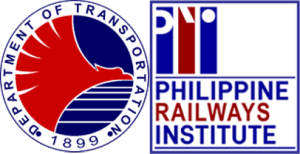
Pursuant to Sec. 10 (a) of the Department Order No. 2020-005 re: Implementing Rules and Regulations (IRR) of Executive Order No. 96, s. 2019 (Establishment of the PRI), the Fundamental Training Course is a training course consisting of of nine (9)
specializations such as: 1) Tracks & Guideways; 2) Buildings & Facilities; 3) Power Supply & Distribution; 4) Signaling & Communications; 5) Rolling Stock; 6) Passenger Management; 7) Fare & Ticketing Management; 8) Commercial Train Driving; and 9) Non-Commercial Train Driving.
This is offered to personnel of new railway lines under the Build, Build, Build Program of the Government. The first cycle of the FT course started on June 21, 2021. To qualify for the FT, the personnel should be newly hired in railway Operation and Maintenance, with less than six (6) months of experience. The personnel should be hired from September 21, 2020 and beyond. The Fundamental Training (FT) Course consists of 3 categories of competencies: Core, Departmental and Specialized.
The whole duration of the fundamental training ranges from 240 to 320 hours. To ensure quality of training, the attendance of trainees is monitored and the passing score of trainees for both Comprehensive Examination and Practical Assessment of the FT course is set at 70%.
All trainees will undergo the Core Competencies. The said competencies consist of values, human skills, institutional framework, and technical knowledge, specifically on railway safety. Thereafter, the trainees will have two (2) options under the Departmental Competencies based on their functions with the railway operators: 1) Operations; and 2) Maintenance. Figure 3 shows the design for the Fundamental Training provided by the PRI to potential railway operations and maintenance personnel.
The Maintenance Departmental Competencies focuses on railway safety, and occupational safety as the PRI’s mission is to inculcate among the railway personnel the safety-first mindset. Human factors and error management are discussed for trainees to foresee these factors and prevent accidents. The trainees also learn the basics of procurement and asset and inventory management. On the other hand, the Operations Departmental track is an introduction to railway operations. Similarly, safety is highlighted in competencies concerning safety for station operation and passenger safety.
After completing the Departmental Competencies, the trainees receive the Specialized Competencies. Those who finish the Operations Departmental Competencies may opt to take: 1) Commercial Train Driving (CTD); 2) Passenger Management (PM); and 3) Fare and Ticketing Management (FTM). On the other hand, those who completed the Maintenance Departmental Competencies shall take any of the following: 1) Tracks and Guideways Maintenance; 2) Buildings and Facilities Maintenance; 3) Signaling and Communications Maintenance; 4) Power Supply and Distribution Maintenance; 5) Rolling Stock Maintenance, and 6) Non-Commercial Train Driving.
HOW TO ENROLL?
All interested individuals shall fill out the online Fundamental Training Application Form;
Submit the hard copy of the Notarized Undertaking Form to Philippine Railways Institute, Unit 63, The Columbia Tower, Ortigas Ave., Brgy. Wack-wack, Mandaluyong City, c/o Abel Trinidad; and
Submit the scanned copy of the Notarized Undertaking Form following via email (td.pri@dotr.gov.ph) with email subject - "FT Course Application Cycle #
NOTE: Incomplete submission is considered as no submission at all.
Pursuant to Sec. 10 (b) of the Department Order No. 2020-005 re: Implementing Rules and Regulations (IRR) of Executive Order No. 96, s. 2019 (Establishment of the PRI), the Refresher Training Course is a training given to existing railway personnel.
In a face-to-face set-up, it is a five (5)-day seminar, while with the asynchronous learning, it is a one (1) month training that aims to enhance the competencies of existing O&M personnel by equipping them with the necessary knowledge, skills, attitude, methods, and processes required to further improve their performance on the job. The personnel are required to undergo and complete the RT Course corresponding to their functions in their respective ROs.
Courses Offered:
- Passenger Management
- Fare and Ticketing Management
- Commercial Train Driving
- Departmental Maintenance
HOW TO ENROLL?
Enrollment is not open for everyone as this is only given to existing railway personnel whose experience and background in railway is more than six (6 months).
If you are an existing railway personnel in one of the railway lines in the Philippines who have not yet taken this course, kindly coordinate with your HR to be scheduled for this training.
Pursuant to Sec. 10 (c) of the Department Order No. 2020-005 re: Implementing Rules and Regulations (IRR) of Executive Order No. 96, s. 2019 (Establishment of the PRI), the Capacity Development Training is a training conducted by the PRI every after five (5) years to update all existing railway personnel on new laws, regulations, and technologies on the railway sector.
NOTE: This training course is not yet offered.
Pursuant to Sec. 10 (d) of the Department Order No. 2020-005 re: Implementing Rules and Regulations (IRR) of Executive Order No. 96, s. 2019 (Establishment of the PRI), the Supervisory/ Management Training Course is a training course for non-O&M personnel or intermediate/ advanced training course for managers and/ or supervisors in the railway sector.
NOTE: This training course is not yet offered.
- Building and Facilities Maintenance
- Commercial Train Driving
- Fare and Ticketing Management
- Passenger Management
- Power Supply and Distribution Maintenance
- Rolling Stock Maintenance
- Signaling and Communications Maintenance
- Tracks and Guideways Maintenance
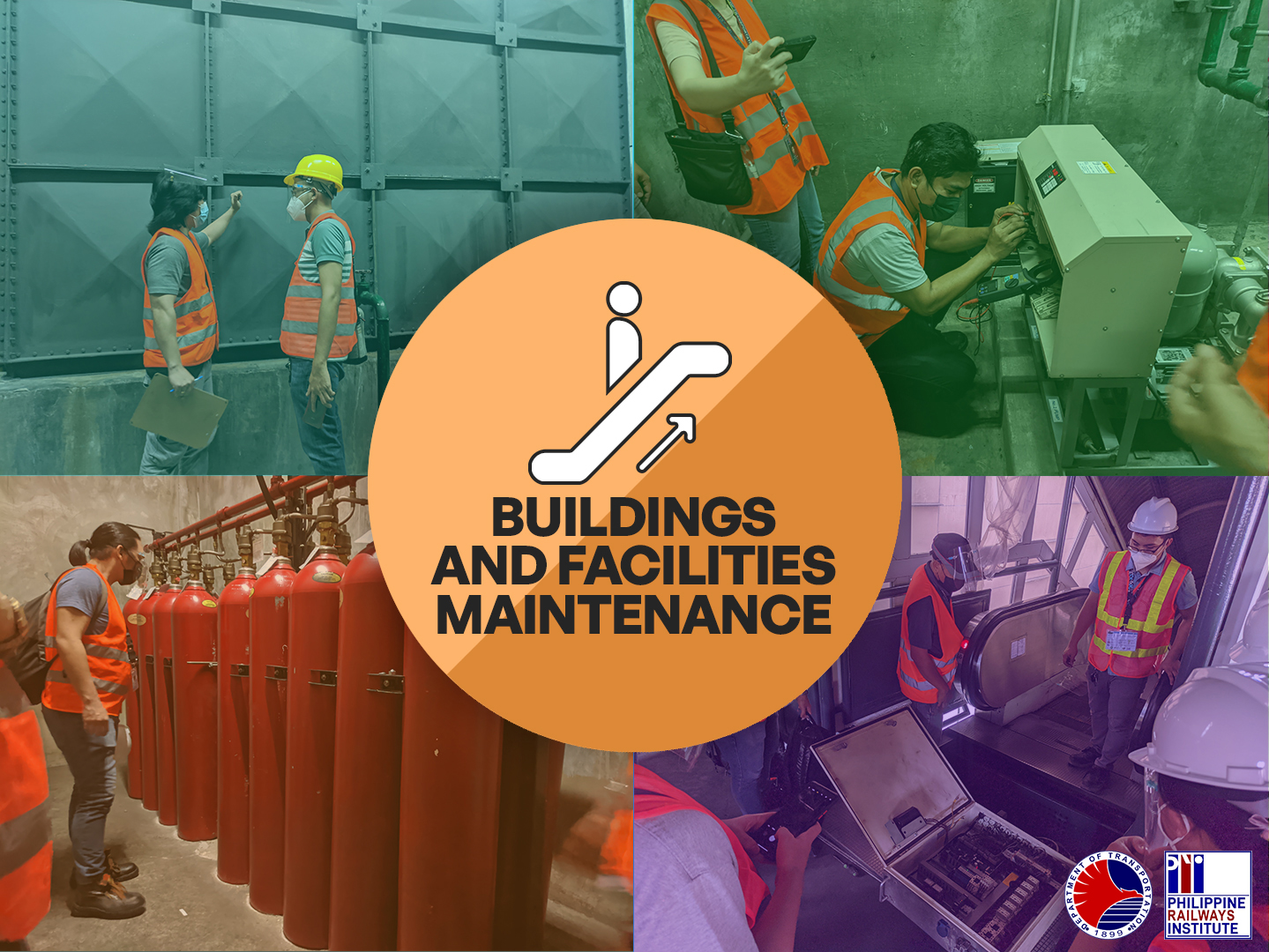
The Buildings and Facilities Maintenance, under the Maintenance competency, is a specialized competency for the maintenance personnel who will undertake the maintenance of the railway buildings, including all its sub-systems. It aims to deliver basic concepts in the building systems, including the platform screen door, which is a facility inside the station building.
LEARNING OUTCOMES:
- Describe the basic concept and functions of civil and architectural system, drainage and sewage disposal system, water supply and distribution system, mechanical facilities, and lighting system and electrical facilities of railway buildings
- Describe the basic concept of platform screen door
- Describe the different safety features of railway buildings
- Describe the standard procedures in maintaining building and facilities service system
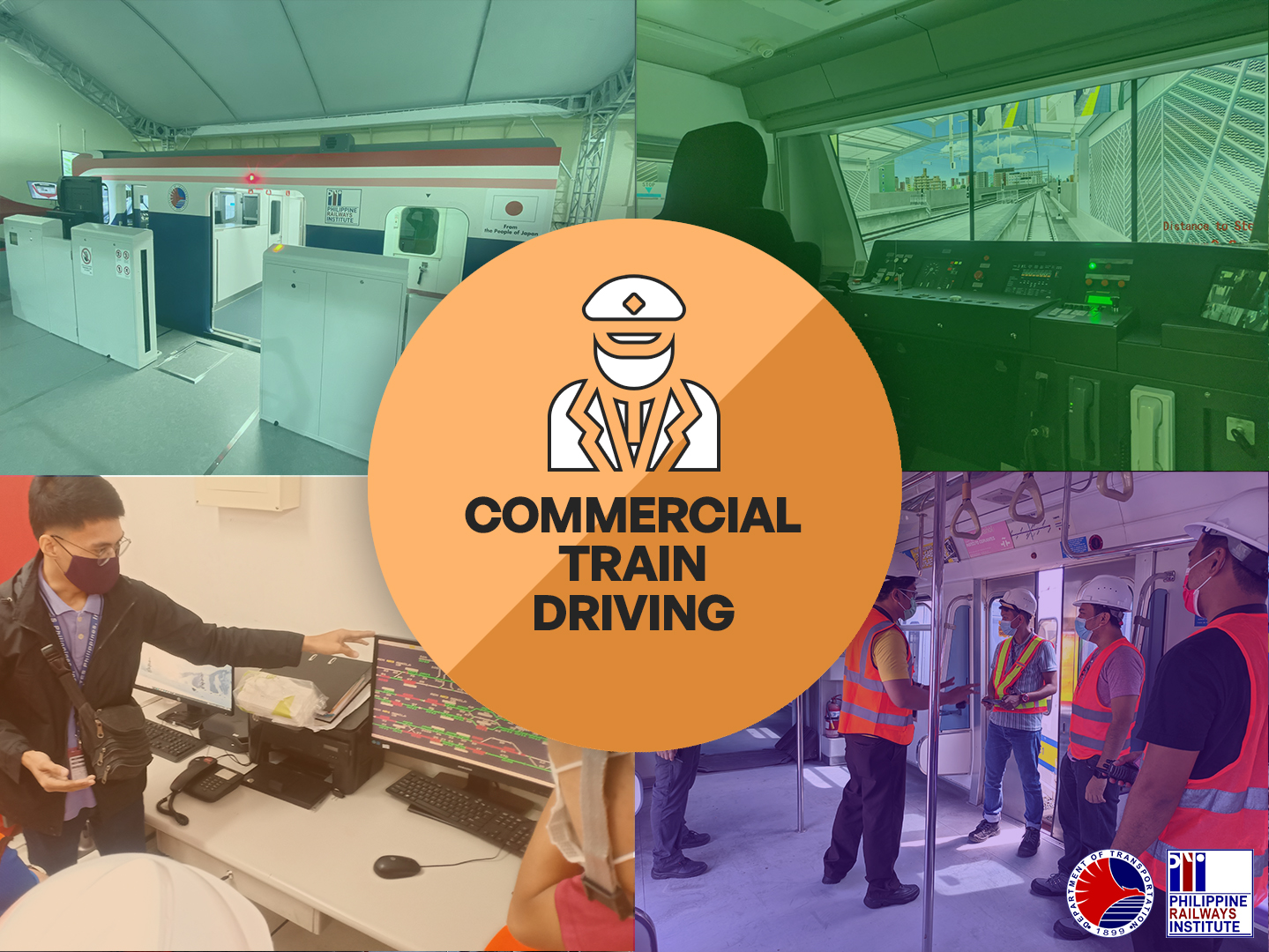
The Commercial Train Driving competency is a list of activities and tasks pertaining to train operation to perform train driver’s role in normal, degraded, and emergency operation.
LEARNING OUTCOME
- Describe the specific duties, responsibilities, and code of conduct of the train driver.
- Recognize the utmost importance of taking the safest course of action (i.e., suspension of train operation) based on the Safety-First Policy in emergency cases.
- Describe the different types of rolling stock and the layout of rolling stock structure, and specifications, and familiarize with the basic components and function of a rolling stock.
- Describe the layout of the vehicle including driving cab, different parts of the rolling stock interior., function and arrangement of its switches and indicators in each end cab.
- Describe and identify exterior equipment and function, names and functions of its major components and subcomponents
- Describe rolling stock door operating equipment
- Discuss the importance of a railway signaling system, describe the different methods of controlling the safe separation of trains through the use of different train detection systems, identify the different train protection components in Automatic Train Control system, identify the different communication systems in railway operations, explain the functions of level crossings.
- Describe the track components, track terminology, track characteristics, platform and track structure
- Understand the basic principles of electricity and explain the different components of a railway electrification system.
- Describe the importance of train operation basic fundamentals
- Describe the features of traction motors
- Describe the characteristic of a train
- Demonstrate how to formulate and calculate running resistance of train
- Identify various types of speed control methods
- Describe the functions and application of braking system in train operation
- Distinguish and discuss the types of train performance curve diagrams that are used in train operation; and interpret the basic details of the projected curve of a train’s performance.
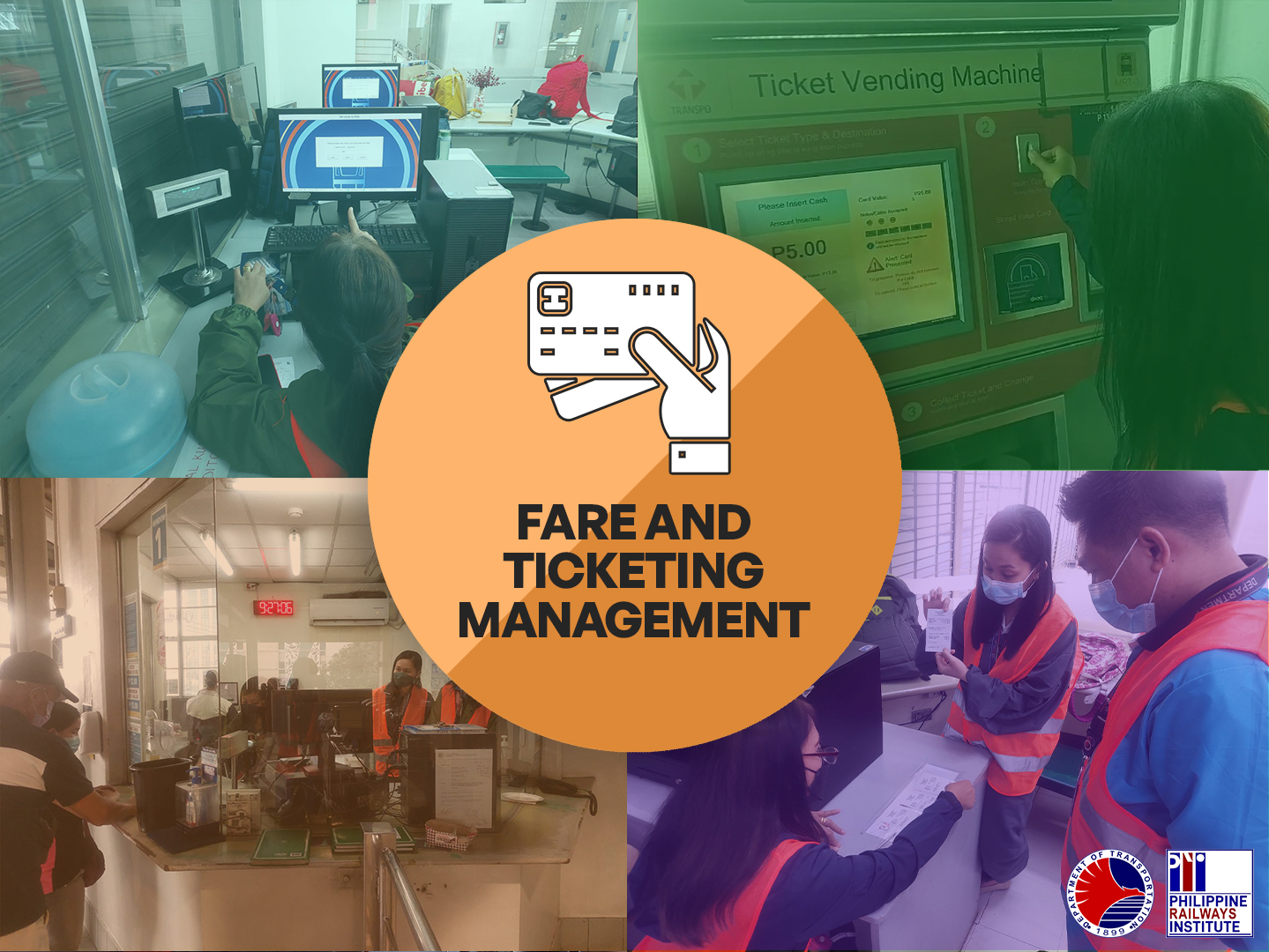
The Fare and Ticketing Management competency are a list of tasks and activities of Ticket Seller in the Station Operation that comprises Ticket and Cash Operational Management Procedure such as Allocation, Ticket Selling, Remittance and also handling passenger during systems and equipment problems.
LEARNING OUTCOMES:
- Identify the evolution of the ticketing system in the railway sector and understand the flow of ticket and cash management while recognizing the importance of coordination with other railway personnel.
- Discuss the initial process of ticket and cash allocation and recognize the importance of managing ticket and cash dealing with discrepancies.
- Understand ticket selling procedures with accuracy, and passenger-oriented service, and assess failures in ticket selling and discrepancies in ticket and cash.
- Identify the ticket and cash management techniques, accomplishing the ticket & cash report and demonstrate knowledge on coping with cash or ticket the discrepancy during remittance.
- Identify situations, know how to deal with Automatic Fare Collection System (AFCS) equipment unavailability and describe proper procedure in handling affected customers/ passenger.
- Familiarize with the different ticket and card issues that the passengers may encounter and understand the proper handling of passenger with ticket and card problem.
- Describe how to deal with passengers’ ticket problems during or after train delays, stoppage of operation, and emergencies, and describe how to apply crowd control measures during such an event.
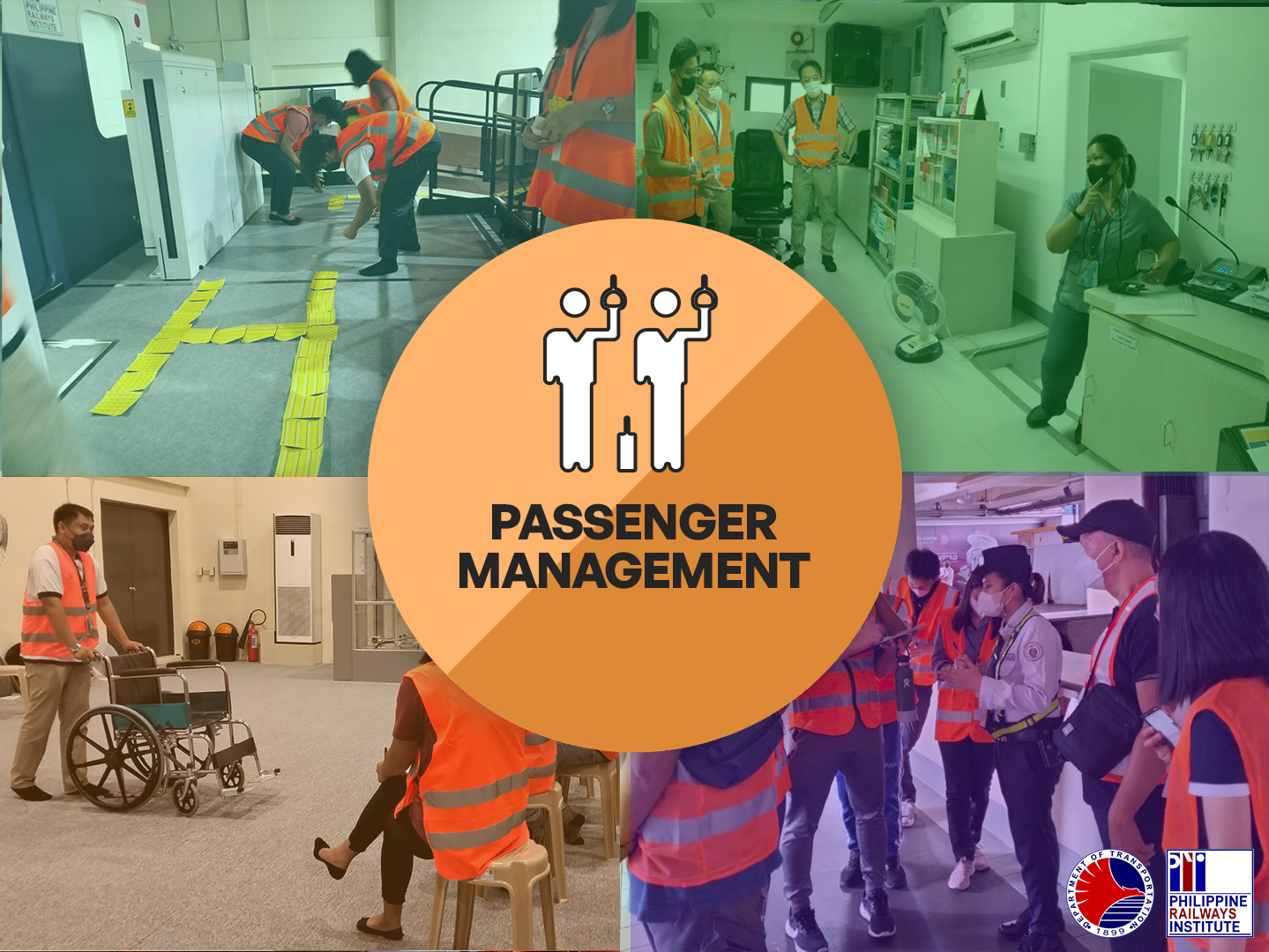
The Passenger Management competency are various lists of tasks and activities of station personnel that comprise of monitoring passengers, station equipment, station environment, and perform the required actions as per operational procedures such as handling customer service, dealing with crowd, complaint, access in the stations, accidents/incidents, service disruptions, and emergency situations.
LEARNING OUTCOMES:
- Distinguish the functional objectives, roles of the different personnel involved in railway operations and sub disciplines of operations such as Train Operations, Operations Control.
- Distinguish the scenarios when the flow of passengers in railway stations need to be managed and perform the ways in maintaining smooth railway operations
- Demonstrate the ability to guide and assist the passengers during the implementation of crowd management strategies in railways stations
- Identify the process of ticket and cash management from allocation to remittance procedures.
- Determine the causes and resolutions in ticket and cards issues .
- Recognize the importance of emergency preparedness, roles and responsibilities of station personnel during emergencies in stations and describe the implementation of Passenger Evacuation Plan.
- Discuss appropriate responses to emergency situations.
- Identify customer service activities required as per operational procedures during normal, degraded and emergency situations.
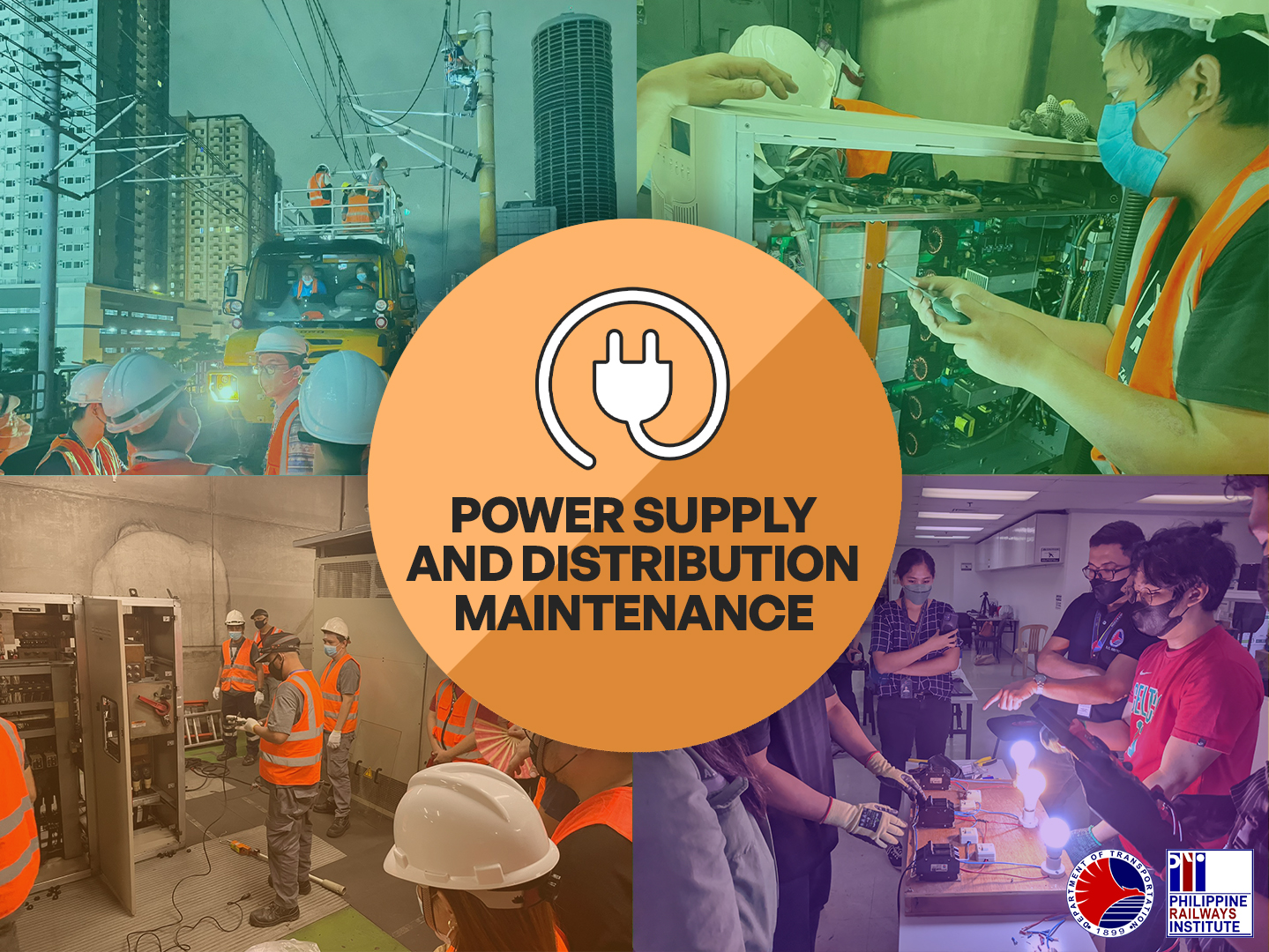
The Power Supply and Distribution Maintenance, under the Maintenance competency, is a specialized competency for the maintenance personnel who will undertake the maintenance of the railway power supply and distribution. It aims to deliver basic concepts in power supply and distribution, describe and apply the concepts of railway power supply systems and facilities. Also to comply with the railway electrical safety practices, and maintenance standard procedures of power supply and distribution.
LEARNING OUTCOMES:
- Understand the basic concepts of electricity and relevant laws governing electricity usage in the Philippines.
- Describe the principles in electric power grid and its application in railway electrification system.
- Describe the power supply system in rail transportation.
- Identify the importance and functions of railway substation facilities and equipment.
- Analyse the operational functions of railway distribution facilities and power facilities for lighting and motive power.
- Describe and analyze electrical hazards and methods to mitigate hazards in workplace.
- Distinguish the appropriate type of PPE needed in their type of work.
- Apply safety handling of different electrical testing and maintenance tools in railway electrification system.
- Demonstrate standard procedures in inspection and maintenance of substation facilities
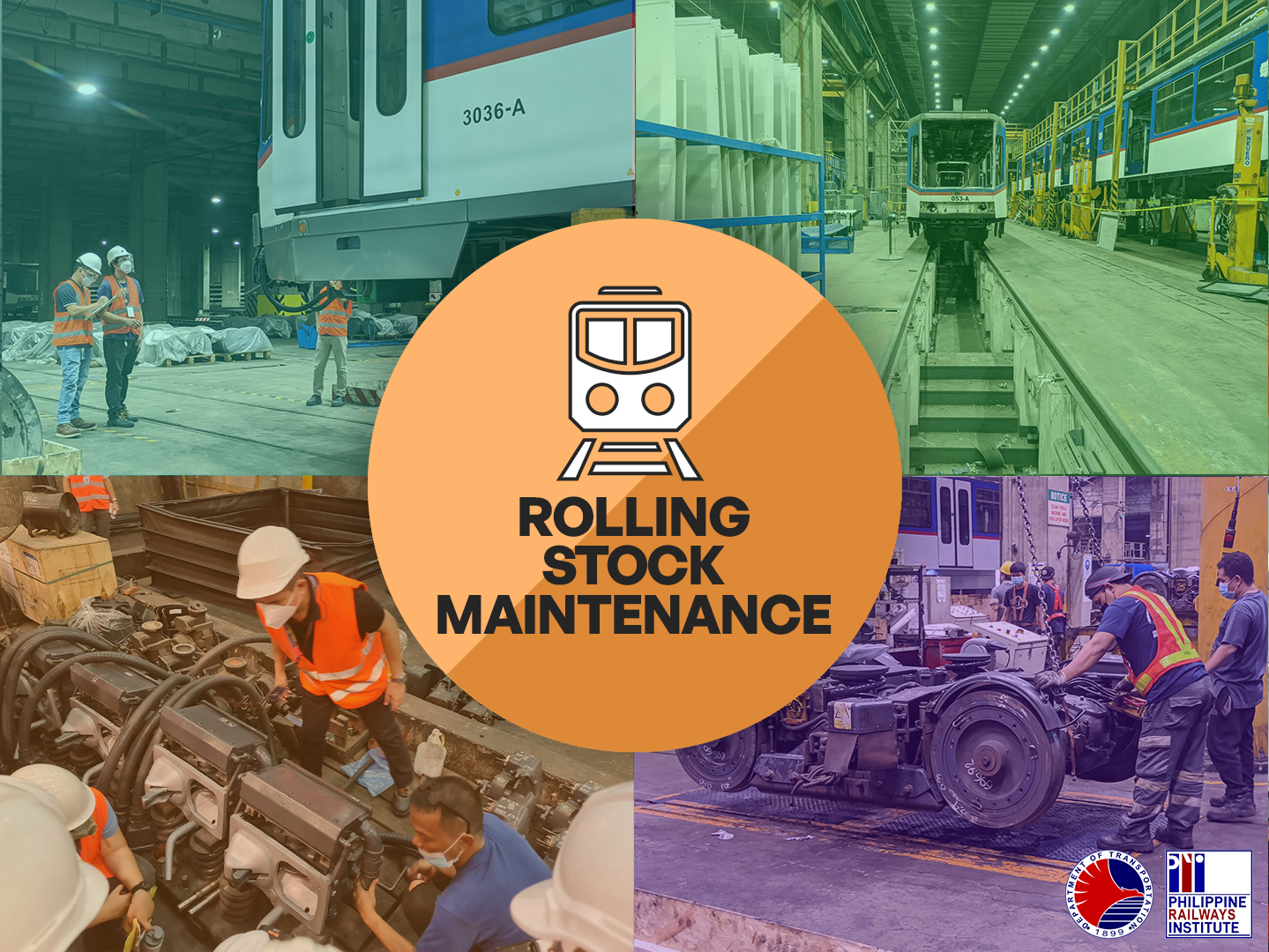
The Rolling Stock Maintenance, under the Maintenance competency, is a specialized competency for the maintenance personnel who will undertake the maintenance of the railway rolling stock maintenance system. Basic concepts and principles of rolling stock technology in the railway transport system. Also, to apply a systematic approach in Rolling Stock Maintenance to sustain optimum level of performance. Diagnose and rectify faults within electrical and electronic circuits and proper use of machines, tools and equipment in Rolling Stock maintenance and safety practices in the workplace.
LEARNING OUTCOMES:
- Describe basic concept and principles of rolling stock in the railway transport system
- Familiarize with the different types of rolling stock
- Describe technical specifications of different rolling stock in existing railway system in the Philippines
- Describe the door functions and mechanism of a railway rolling stock
- Describe the Drivers Cab and Holster Control functions and mechanism of a railway rolling stock
- Describe the Ventilation and Air Conditioning System functions, importance and mechanism in a railway rolling stock
- Understand the different maintenance activities performed of Ventilation and Air Conditioning System of a Rolling Stock
- Describe components and functions of a rolling stock bogie maintenance
- Describe and apply the concepts and functions of a train braking system
- Demonstrate the functions of each component in train control system
- Recognize the importance of the power supply system in railways and learn how to assess power supply system conditions.
- Understand concepts of maintenance procedure in propulsion system
- Describe basic concepts and apply basic maintenance procedure of a rolling stock coupling system
- Describe concept and strategy of rolling stock preventive maintenance
- Describe concept and strategy of rolling stock corrective maintenance
- Understand basic concept of electricity and electronics application in railway rolling stock system
- Distinguish the appropriate type of hand tools, equipment and PPEs needed in their type of work.
- Demonstrate and realize the importance of safety in the workplace.
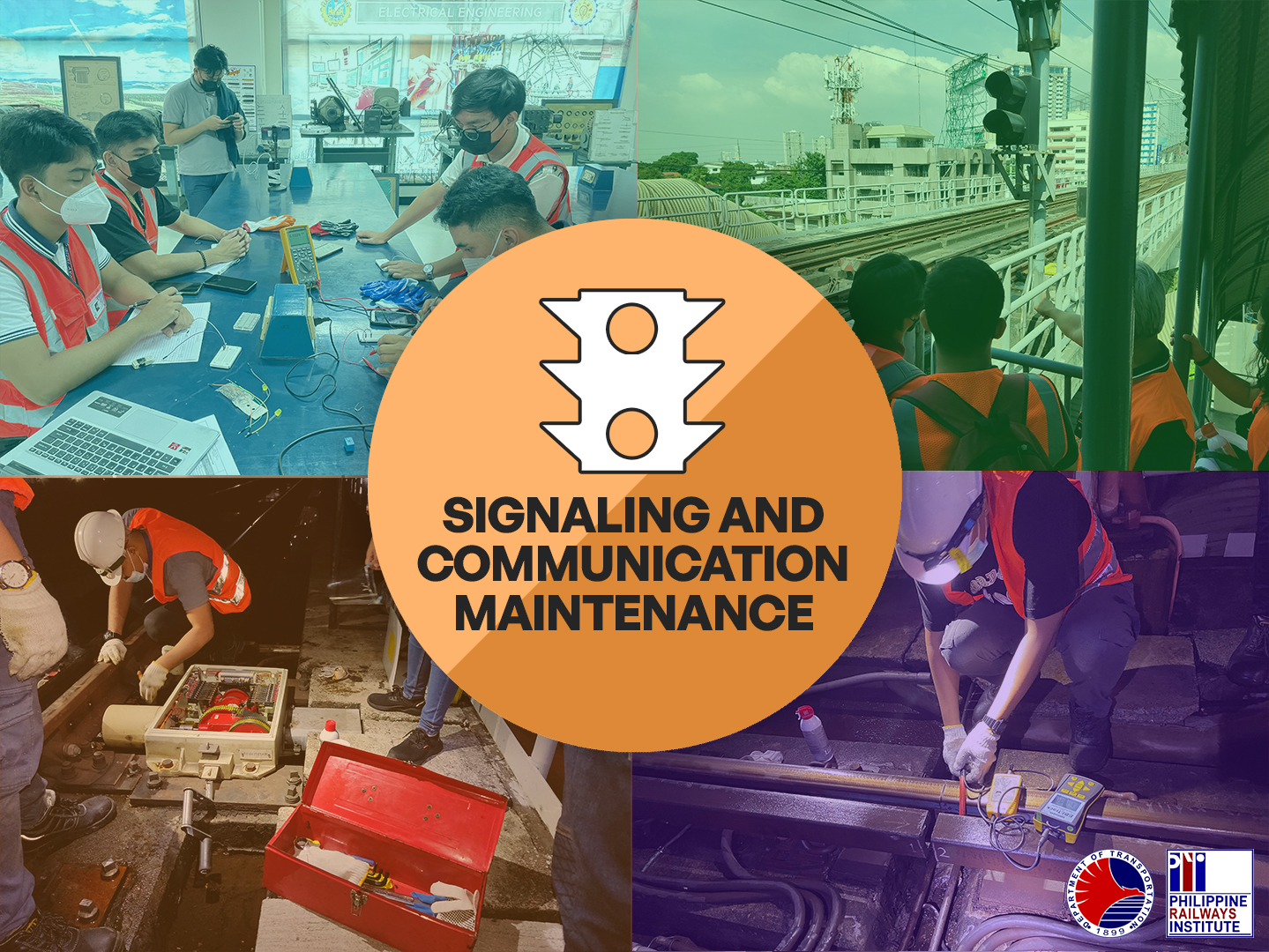
The Signaling and Communications Maintenance, under the Maintenance competency, is a specialized competency for the maintenance personnel who will undertake the maintenance of the railway signaling and communications. It aims to deliver basic concepts in signaling and communications, railway safety practices in working on electrical and electronics equipment and standard procedure in maintenance of facilities, equipment and tools.
LEARNING OUTCOMES:
- Describe the fundamental of Platform Screen Door operation
- Describe and analyze electrical hazards and methods to mitigate hazards and abnormalities in workplace
- Apply maintenance standard procedure in railway signaling facilities, equipment and other communication facilities.
- Recognize the importance and fundamental of SCADA system
- Describe the fundamental of Level crossing protection system
- Identify the appropriate type of hand tools, equipment and measuring devices in their type of work.
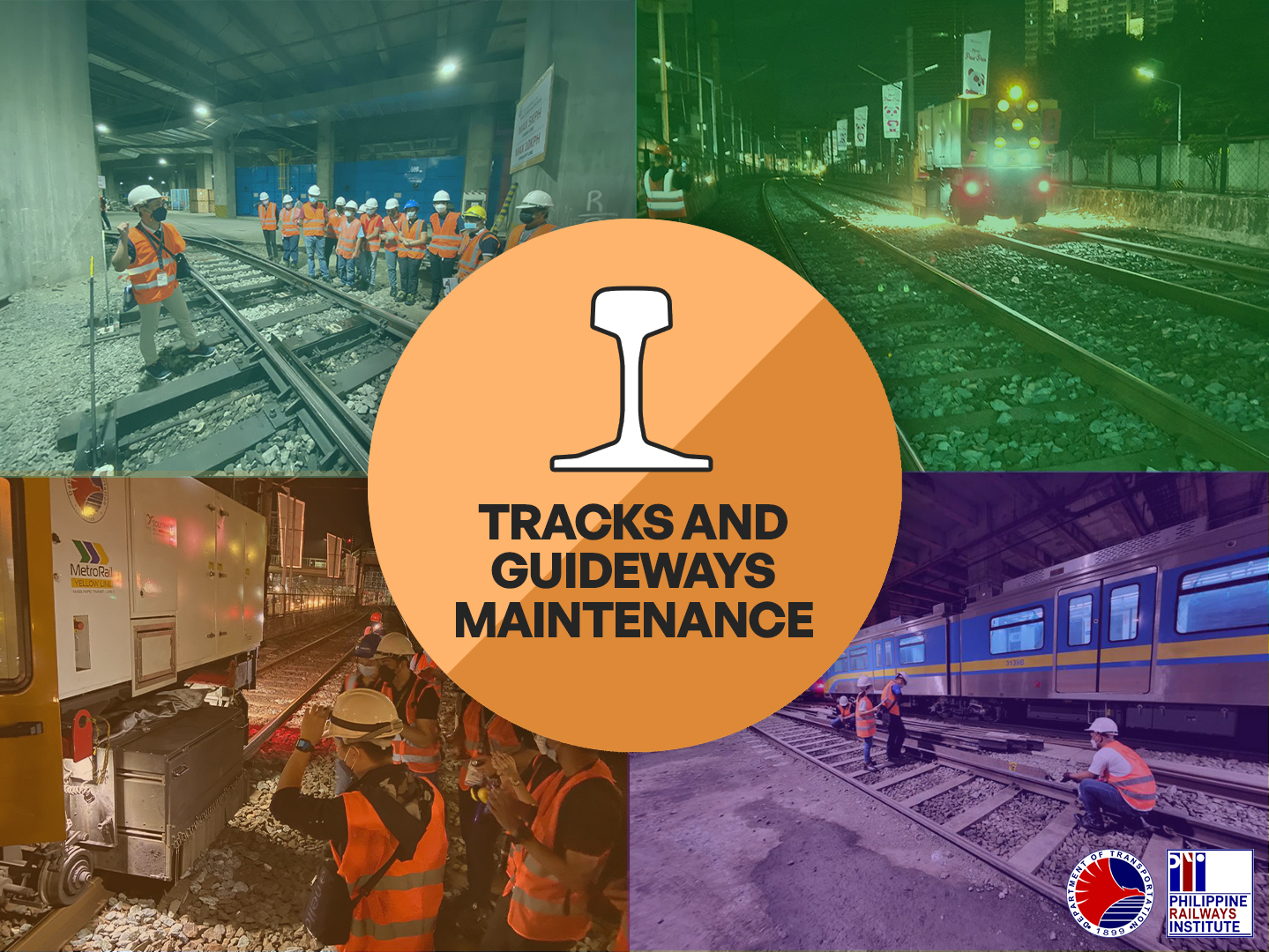
The Tracks and Guideways Maintenance, under the Maintenance competency, is a specialized competency for the maintenance personnel who will undertake the maintenance of the railway tracks and guideways. It aims to deliver basic concepts in track structures, alignments, track guideways, and maintenance as well as fundamentals of structural design.
LEARNING OUTCOMES:
- Describe the functions and characteristics of rail track structure components and track turnout components
- Understand the different methods of tangent track alignment and geometrical alignment
- Employ appropriate procedures in conducting preventive and corrective maintenance of track structures
- Understand the fundamentals of structural mechanics, reinforced concrete, steel structures, and earthworks and soil mechanics
- Differentiate the levels of track guideways
- Demonstrate basic knowledge in repairing minor defects in guideway structures and elements


